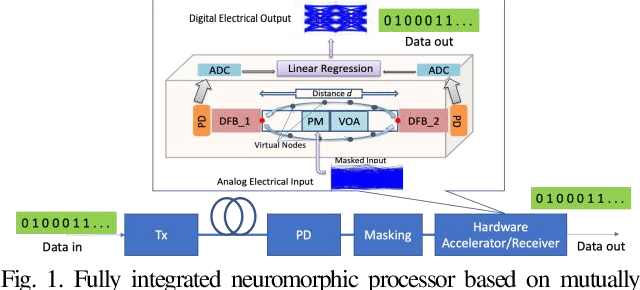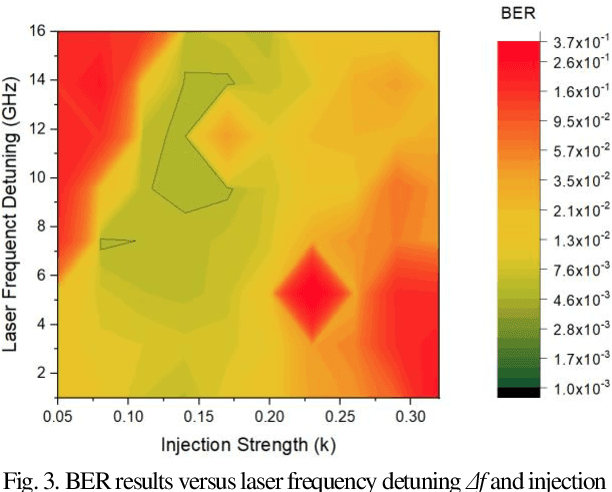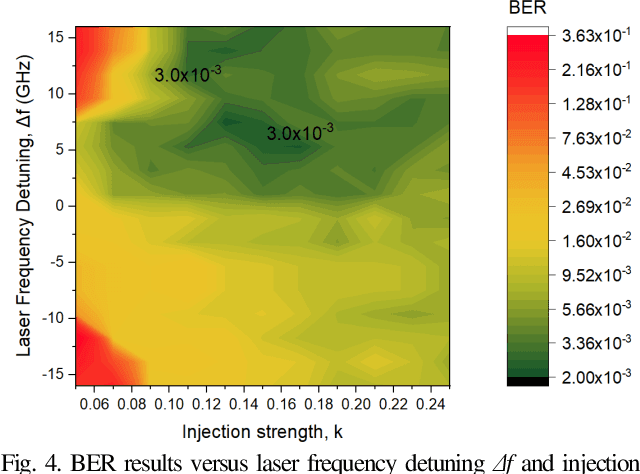Kostas Sozos
Unconventional Computing based on Four Wave Mixing in Highly Nonlinear Waveguides
Feb 14, 2024



Abstract:In this work we numerically analyze a photonic unconventional accelerator based on the four-wave mixing effect in highly nonlinear waveguides. The proposed scheme can act as a fully analogue system for nonlinear signal processing directly in the optical domain. By exploiting the rich Kerr-induced nonlinearities, multiple nonlinear transformations of an input signal can be generated and used for solving complex nonlinear tasks. We first evaluate the performance of our scheme in the Santa-Fe chaotic time-series prediction. The true power of this processor is revealed in the all-optical nonlinearity compensation in an optical communication scenario where we provide results superior to those offered by strong machine learning algorithms with reduced power consumption and computational complexity. Finally, we showcase how the FWM module can be used as a reconfigurable nonlinear activation module being capable of reproducing characteristic functions such as sigmoid or rectified linear unit.
Integrated Photonic Accelerator Based on Optical Spectrum Slicing for Convolutional Neural Networks
Mar 18, 2023



Abstract:In this work we numerically analyze a passive photonic integrated neuromorphic accelerator based on hardware-friendly optical spectrum slicing nodes. The proposed scheme can act as a fully analogue convolutional layer, preprocessing information directly in the optical domain. The proposed scheme allows the extraction of meaningful spatio-temporal features from the incoming data, thus when used prior to a simple fully connected digital single layer network it can boost performance with negligible power consumption. Numerical simulations using the MNIST dataset confirmed the acceleration properties of the proposed scheme, where 10 neuromorphic nodes can replace the convolutional layers of a sophisticated LeNet-5 network, thus reducing the number of total floating point operations per second (FLOPS) by 98% while offering a 97.2% classification accuracy.
Reservoir Computing based on Mutually Injected Phase Modulated Semiconductor Lasers as a monolithic integrated hardware accelerator
May 22, 2021



Abstract:In this paper we propose and numerically study a neuromorphic computing scheme that applies delay-based reservoir computing in a laser system consisting of two mutually coupled phase modulated lasers. The scheme can be monolithic integrated in a straightforward manner and alleviates the need for external optical injection, as the data can be directly applied on the on-chip phase modulator placed between the two lasers. The scheme also offers the benefit of increasing the nodes compared to a reservoir computing system using either one laser under feedback or laser under feedback and optical injection. Numerical simulations assess the performance of the integrated reservoir computing system in dispersion compensation tasks in short-reach optical communication systems. We numerically demonstrate that the proposed platform can recover severely distorted 25 Gbaud PAM-4 signals for transmission distances exceeding 50km and outperform other competing delay-based reservoir computing systems relying on optical feedback. The proposed scheme, thanks to its compactness and simplicity, can play the role of a monolithic integrated hardware accelerator in a wide range of application requiring high speed real time processing.
Spatial Photonic Reservoir Computing based on Non-Linear Phase-to-Amplitude Conversion in Micro-Ring Resonators
Jan 12, 2021Abstract:We present a photonic reservoir computing, relying on a non-linear phase-to-amplitude mapping process, able to classify in real-time multi-Gbaud time traces subject to transmission effects. This approach delivers an all-optical, low-power neuromorphic dispersion compensator.
 Add to Chrome
Add to Chrome Add to Firefox
Add to Firefox Add to Edge
Add to Edge